Works
The role as scholar of the older brother, Lorenzo is more relevant: many known works are signed by him alone, but anyone is undoubtedly ascribable to Jacopo. Several Salimbenian works can be viewed in San Severino: some frescoes coming from the old cathedral and depicting the episodes of Saint John the Evangelist, have been reassembled in the vault of Civic Pinacotheca in San Severino. The two painters frescoed the Basilica of San Lorenzo in Doliolo, the San Domenico Church and the old Cathedral of Saint Maria della Pieve in San Severino.
In spite of his great artistic production the majority of his paintings are scattered through both Marche and many important museums in all the world, [2] [3] with only three valuable paintings being displayed in the Civic Pinacotheca of San Severino: the Virgin Mary in throne with the Child among Saints John Baptist and Agostino, the Pietà [4] the Nativity. In Saint Mary of Majesty church in Parolito, a town very close to San Severino, are conserved five frescoes ascribed to D’Alessandro.
Lorenzo and Jacopo painted frescoes of John the Baptist in Urbino. Lorenzo painted an altarpiece of Madonna and child with St. Catherine receiving ring and St Domenic and glory of angels for the church of Santa Lucia in Fabriano, now displayed in the National Gallery of London. [5]
In spite of their production was limited to few provinces of east-central Italy, their stylistic elements are representative of the internationalization of that pictorial language.

Lorenzo Lotto was an Italian painter, draughtsman, and illustrator, traditionally placed in the Venetian school, though much of his career was spent in other north Italian cities. He painted mainly altarpieces, religious subjects and portraits. He was active during the High Renaissance and the first half of the Mannerist period, but his work maintained a generally similar High Renaissance style throughout his career, although his nervous and eccentric posings and distortions represented a transitional stage to the Florentine and Roman Mannerists.

Pinturicchio, or Pintoricchio, also known as Benetto di Biagio or Sordicchio, was an Italian painter during the Renaissance. He acquired his nickname because of his small stature and he used it to sign some of his artworks that were created during the fifteenth and sixteenth centuries.

Pietro Perugino, born Pietro Vannucci, was an Italian Renaissance painter of the Umbrian school, who developed some of the qualities that found classic expression in the High Renaissance. Raphael was his most famous pupil.
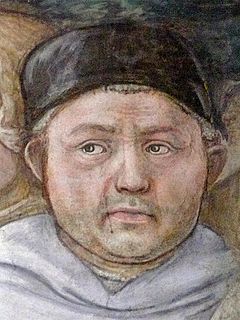
Filippo Lippi, also known as Lippo Lippi, was an Italian painter of the Quattrocento and a Carmelite Priest.

Alessandro Bonvicino, more commonly known as Moretto, or in Italian Il Moretto da Brescia, was an Italian Renaissance painter from Brescia, where he also mostly worked. His dated works span the period from 1524 to 1554, but he was already described as a master in 1516. He was mainly a painter of altarpieces that tend towards sedateness, mostly for churches in and around Brescia, but also in Bergamo, Milan, Verona, and Asola; many remain in the churches they were painted for. Most are on canvas, but a number even of large ones are on wood panel. Only a handful of drawings survive.
Bernardo Castello (1557–1629) was an Italian painter of the late-Mannerist style, active mainly in Genoa and Liguria. He is mainly known as a portrait and historical painter.

Ventura di Archangelo Salimbeni was an Italian Counter-Maniera painter and printmaker highly influenced by the vaghezza and sensual reform of Federico Barocci.
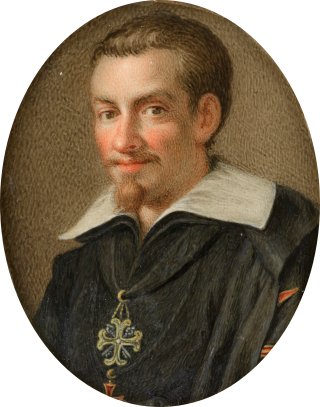
Francesco Vanni was an Italian painter, draughtsman, printmaker, publisher and printer active in Rome and his native city of Siena.

The Dominican Church, also known as the Church of St. Maria Rotunda, is an early Baroque parish church and minor basilica in the historic center of Vienna, Austria. It is the third church built on the same site in the course of time.
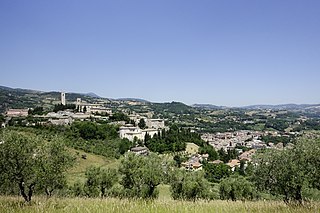
San Severino Marche is a comune (municipality) in the Province of Macerata in the Italian region Marche, located about 50 kilometres (31 mi) southwest of Ancona and about 25 kilometres (16 mi) southwest of Macerata.

Jacopo di Cione was an Italian Gothic period painter in the Republic of Florence.
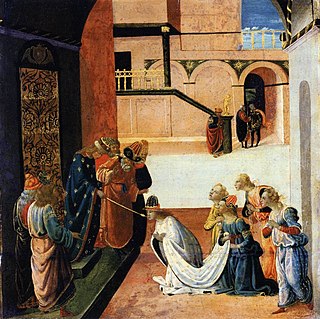
Jacopo del Sellaio (1441/2–1493), was an Italian painter of the early Renaissance, active in his native Florence. His real name was Jacopo di Arcangelo. He worked in an eclectic style based on those of Botticelli, Filippino Lippi, and Domenico Ghirlandaio. The nickname Sellaio derives from the profession of his father, a saddle maker.

Lorenzo di Bicci was an Italian painter of the Florentine School considered to be one of the most important painters in Florence during the second half of the 14th century. He is believed to have learned his trade from his father, about whom little is known. Lorenzo’s style, as well as that of his contemporaries Jacopo di Cione and Niccolò di Pietro Gerini, was influenced by the artist Andrea di Cione. Lorenzo's paintings made use of bright colors and his compositions avoided complexity. The figures he painted tended to have round faces and were often expressionless. Another one of Lorenzo's distinctive characteristics was his precision of execution. He was known for exceptional talent in drawing, an ability that he put to use at the initial stages of his painting. Unlike many celebrated Florentine artists of this period, Lorenzo mostly received commissions from the country clergy and from the lower-middle class Florentine guilds. His successors, Bicci di Lorenzo and Neri di Bicci, continued to serve these groups.
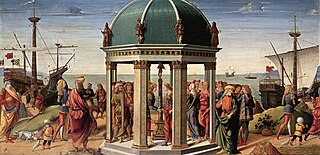
Biagio d’Antonio Tucci was an Italian Renaissance painter active in Florence, Faenza and Rome.

Giovanni Boccati or Giovanni di Pier Matteo Boccati was an Italian painter.

Lorenzo d’Alessandro was an Italian painter and interpreter of late gothic style. He is known by different authorities and authors by different names, including:
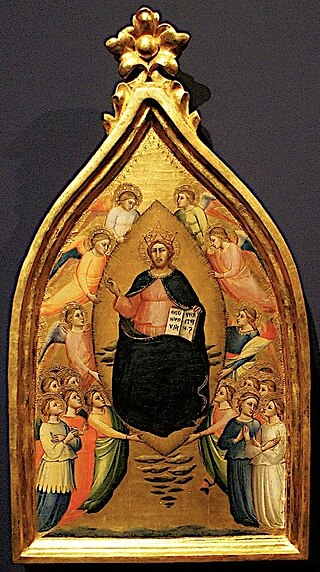
Mariotto di Nardo di Cione was a Florentine painter in the Florentine Gothic style. He worked at the Duomo of Florence, the church of Santa Maria Maggiore, and the Orsanmichele. He created both frescoes and panel paintings, and was also active as a manuscript illuminator.

The Pinacoteca Civica Padre Pietro Tacchi Venturi is the civic art gallery of the town of San Severino Marche, region of Marche, Italy. Located at Via Salimbeni 39, it mainly displays sacred paintings from prior centuries.
San Domenico or St Dominic is a 13th-century, Roman Catholic church, dedicated to a Marian devotion, located on Via E Rosa in San Severino Marche, region of Marche, Italy.
The Master of Staffolo was an anonymous late-Gothic style painter active in the region of Marche and Umbria.

















